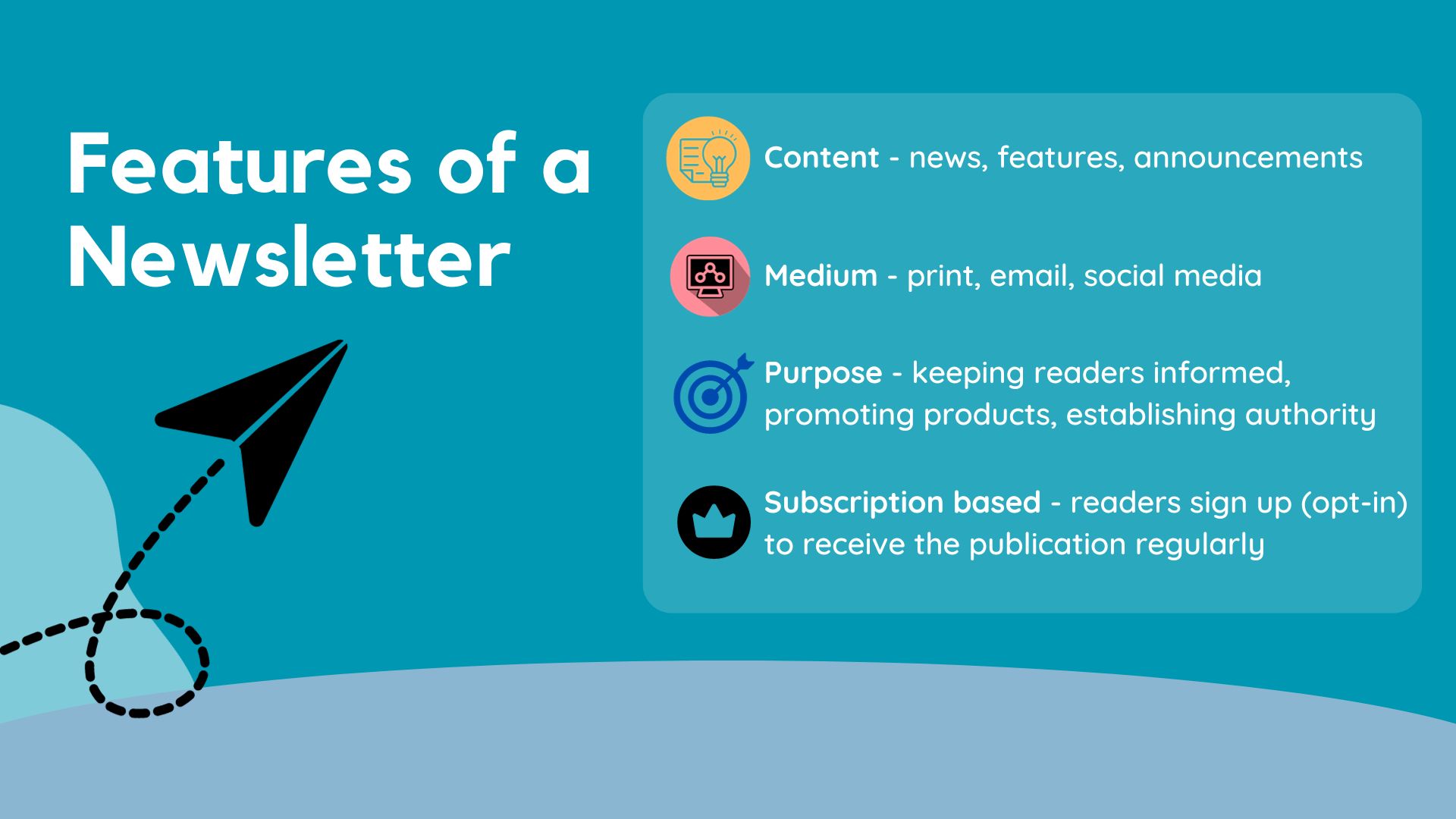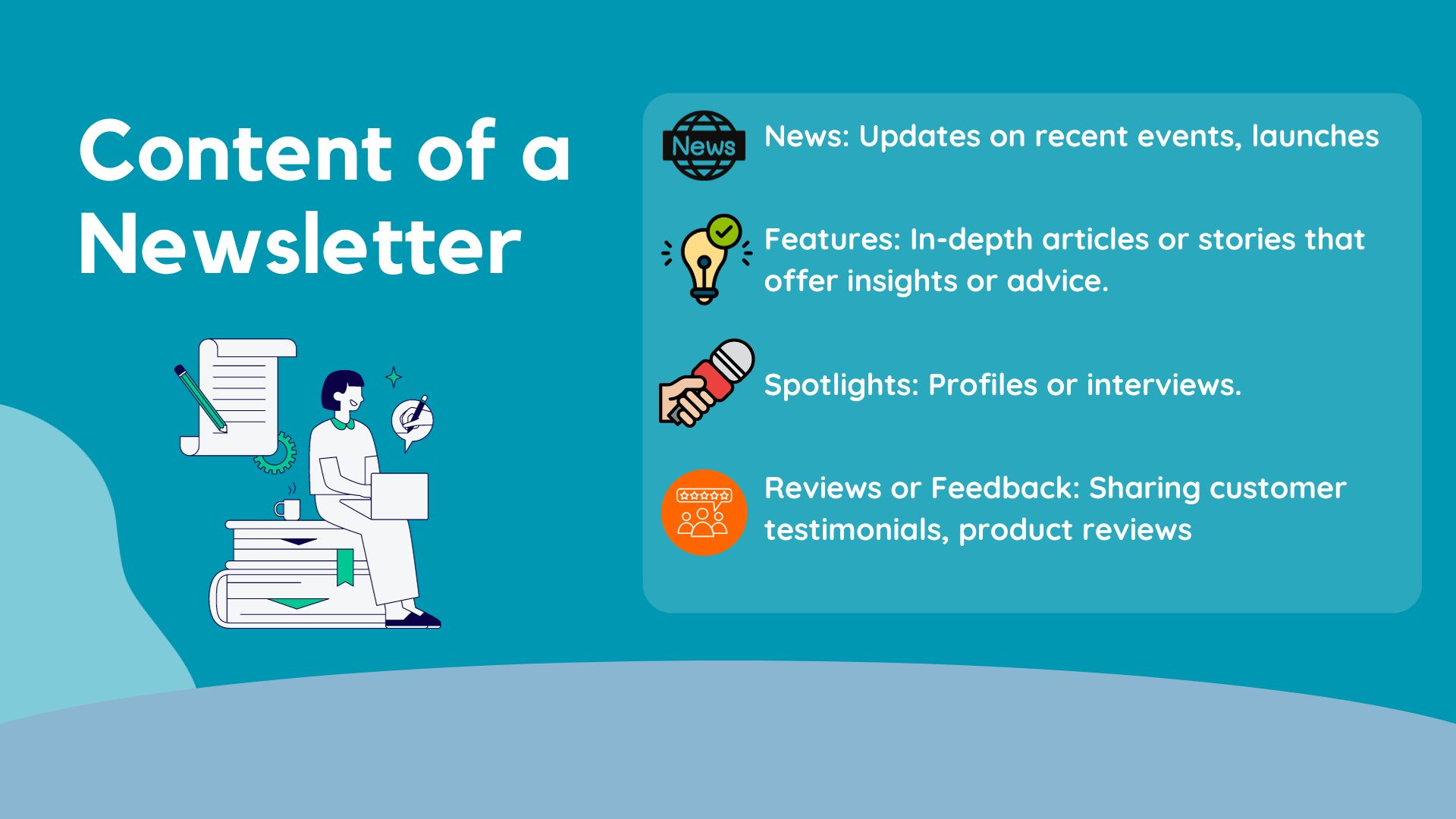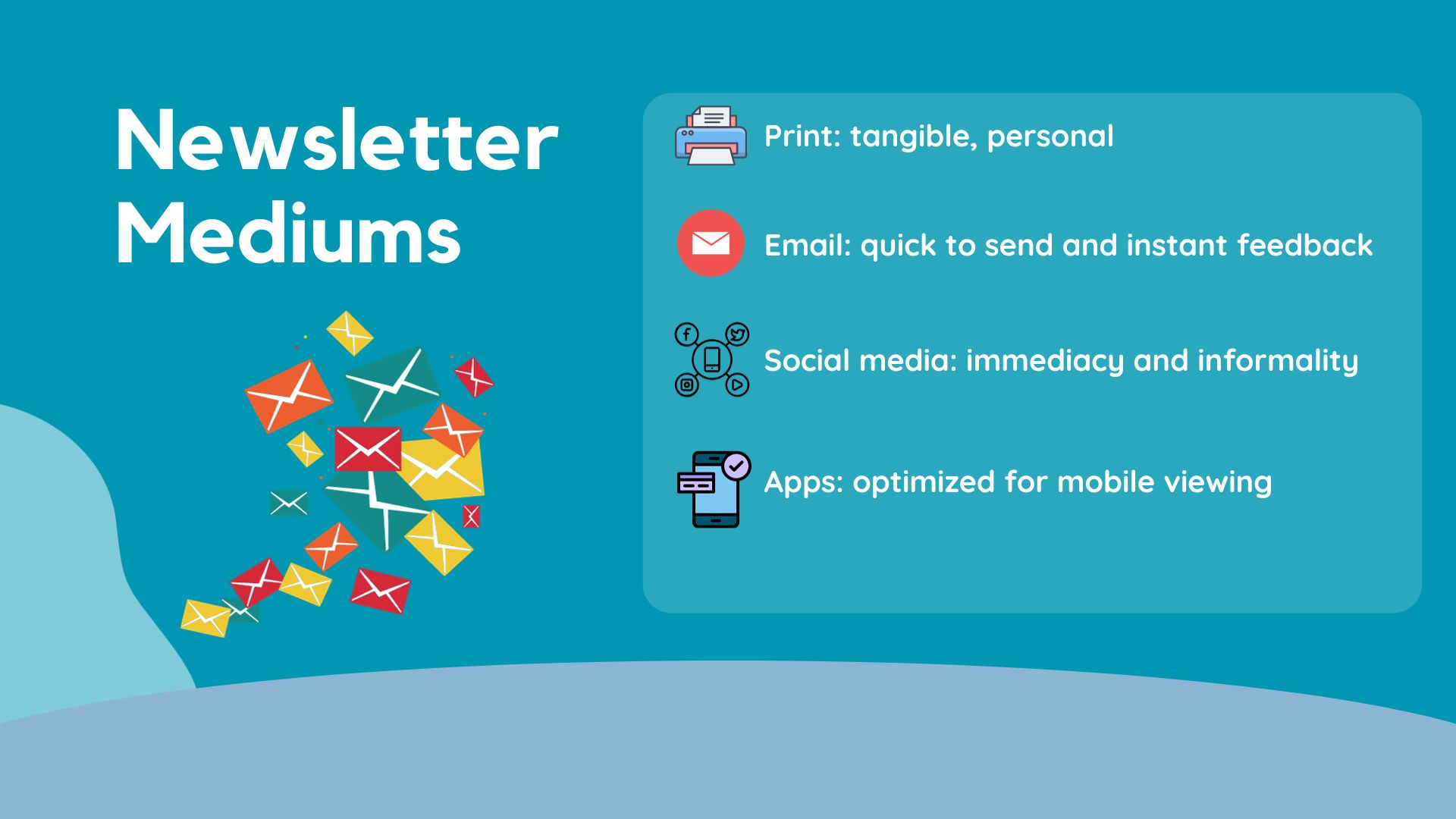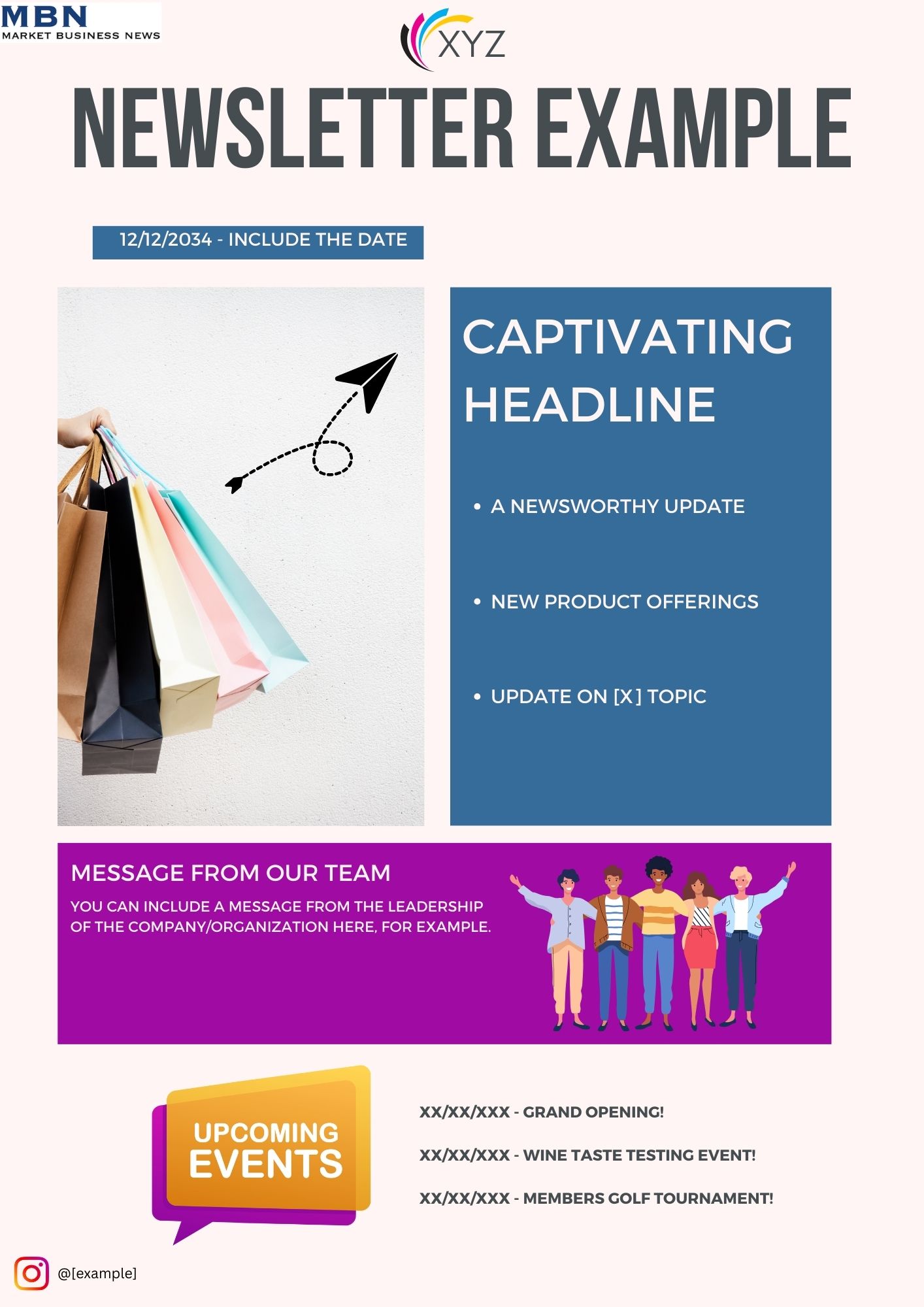A newsletter is a periodic publication, often delivered via email, that provides subscribers with information or updates on a particular topic, organization, or interest. Newsletters can be issued daily, weekly, monthly, or at any other regular interval. It is a form of media that can be aimed at a wide range of audiences – from corporate staff to club members to online shoppers.
It’s imperative when creating a newsletter to understand the need to have a clear message and objective.
According to Mailchimp: “One of the first steps to creating an effective newsletter is to recognize that it is a marketing campaign that needs to have a clear message and a clear objective.”
Key features of a newsletter

Content
Newsletters serve as a platform for organizations or individuals to communicate with a defined audience. The content within them can vary widely based on the purpose of the newsletter, its audience, and the industry it caters to. Here’s a more detailed breakdown:

- Types of Content:
- News: Updates on recent events, launches, or any significant changes within the organization or the field it belongs to.
- Features: In-depth articles or stories that offer insights, advice, or delve deep into a particular topic.
- Announcements: Information about upcoming events, promotions, product launches, or any noteworthy forthcoming activities.
- Spotlights: Profiles or interviews of staff members, customers, or industry experts to give a more personal touch or share expertise.
- Reviews or Feedback: Sharing customer testimonials, product reviews, or feedback received to build trust.
- Ways Content is Typically Written:
- Tone and Style: The tone can vary from formal (in corporate newsletters) to casual (in more community-driven or personal newsletters). The style could be informative, persuasive, entertaining, or a combination.
- Brevity and Clarity: Given that readers often skim through newsletters, the content is usually concise with clear headlines, bullet points, and call-to-actions.
- Use of Visuals: Images, infographics, and other visuals are frequently used to break the monotony of text, making the newsletter more engaging.
- Formatting of the Content:
- Headers and Subheaders: These are used to break up the content and make it easily scannable.
- Columns: Especially in printed newsletters, content might be organized into columns, much like a newspaper.
- Sections: Different types of content may be categorized into distinct sections with separators or distinct color backgrounds.
- Interactive Elements: In digital newsletters, there might be interactive elements like buttons, links, or embedded videos.
- Authorship:
- By the Company/Organization: Many times, the content is presented as coming from the organization as a whole, especially for formal announcements or news.
- Individual Authors: Feature articles, expert advice, or personal stories might have individual bylines, showcasing the author’s name and sometimes their position or role.
- Guest Contributors: Some newsletters invite guest writers or experts in the field to contribute, lending more credibility or a fresh perspective to the content.
While newsletters share a common goal of engaging and informing their audience, the specifics of their content, style, and presentation can differ significantly based on the context in which they are produced and the audience they cater to.
Medium

Newsletters have always been a reliable way to stay updated, whether about a local community, a global movement, or a special interest. How we get them has changed over time, though:
- Printed Newsletters:
- Historic Role: Before the ubiquity of the internet, newsletters were typically printed and mailed out or distributed in person.
- The Charm: There’s an intrinsic value in physical newsletters – they’re tangible, personal, and sometimes collectible.
- Current Usage: While their prevalence has decreased with digital alternatives, they’re still cherished in settings like local communities, schools, or by audiences that value the printed format.
- Digital Newsletters:
- Via Email: Today, many of us receive newsletters in our inboxes. They can be vibrant with videos, clickable links, and dynamic content. They’re quick to send, and feedback, like open rates, is almost immediate.
- On the Web: Some organizations archive newsletters on their websites. This means anyone can access them anytime, creating a rich repository of past updates.
- Mobile and Apps: As smartphones have become extensions of ourselves, some newsletters are optimized for mobile viewing or even come through apps.
- Through Social Media: Platforms like Telegram or Instagram stories are newer avenues where newsletter-like content is reaching audiences. It’s a blend of immediacy and informality.
- Choosing the Right Medium:
- Who’s Reading: It’s crucial to know your audience. Do they check their emails often? Or would they appreciate a physical copy to read at leisure?
- Content Matters: If you’re sharing a lot of videos or interactive content, digital might be the way to go. On the other hand, a beautifully crafted print edition can be a collector’s item.
- Costs and Impact: Digital newsletters can be more cost-effective and environmentally friendly. But sometimes, the impact of a printed piece might justify its costs.
So, whether it’s the nostalgia of paper or the convenience of digital, newsletters have continued to adapt, ensuring they remain a valuable source of information and connection for us all.
Purpose
The main purposes of a newsletter include keeping readers informed, promoting products or services, establishing authority in a particular field, and fostering community among its subscribers.
Subscription-based model
Newsletters work on a subscription (opt-in) basis – this can be either free or paid for.
- Free Subscriptions: Many newsletters are offered for free to subscribers. The primary aim of these newsletters can be to engage with an audience, keep them informed, or even to market other products or services indirectly.
- Paid Subscriptions: Some newsletters charge a subscription fee, offering premium content, in-depth analysis, ad-free reading, or other perks that free versions don’t provide.
Examples of organizations using newsletters
- Furniture Company: A furniture company might send a monthly newsletter to its customers, updating them about new pieces of furniture, discounts, and other information that customers may find interesting.
- Local Community Center: A local community center might issue a quarterly newsletter detailing upcoming community events, classes, and news.
- Health Clinic: A local health clinic might distribute a bi-monthly newsletter highlighting seasonal health tips, new medical procedures available, and profiles of newly joined doctors.
- School: A school could send out a weekly newsletter to parents and students, providing updates on school events, achievements, exam schedules, and parent-teacher meeting dates.
- Travel Agency: A travel agency might send a seasonal newsletter showcasing top travel destinations for the upcoming season, travel tips, special package deals, and customer reviews or testimonials.
- Bookstore: A bookstore might produce a monthly newsletter introducing new book releases, author interviews, upcoming book signings, and reading recommendations based on popular genres.
- Gardening Club: A gardening club could issue a monthly newsletter to its members with tips on seasonal planting, how to care for specific plants, spotlight on a particular plant species, and member spotlights or success stories.
- Fitness Gym: A fitness gym might share a quarterly newsletter with workout tips, nutrition advice, profiles on trainers, and announcements about new classes or equipment.
- Non-profit Organization: A non-profit working on environmental issues might send out a monthly newsletter updating its supporters about recent projects, success stories, upcoming events, and ways to contribute or volunteer.
- Local Farmer’s Market: A farmer’s market could distribute a weekly newsletter highlighting new vendors, available seasonal produce, recipes, and profiles of local farmers.
Visual example of a newsletter

Of course, newsletters vary vastly, this comes down to a range of factors: Who is sending the newsletter? Who is the target audience? What is the objective? How is it going to be shared? What information is being shared? All these factors shape what newsletters end up looking like.
